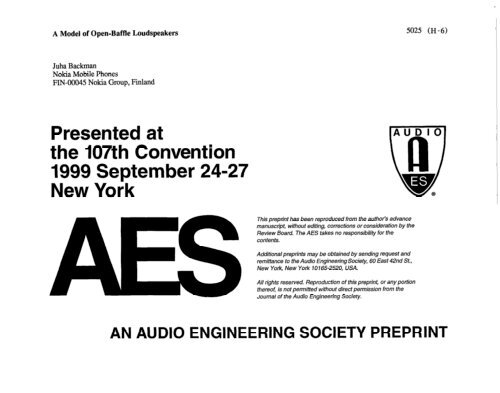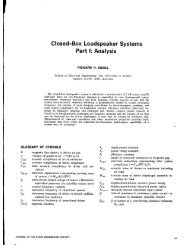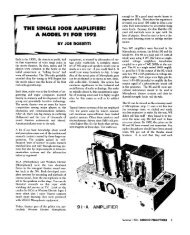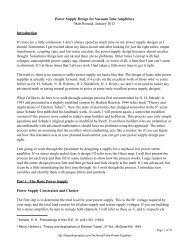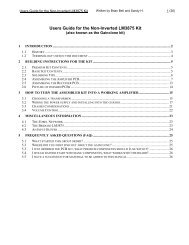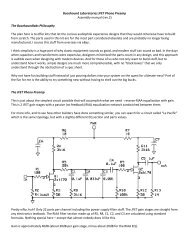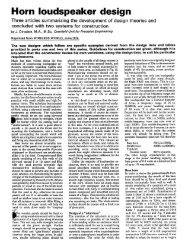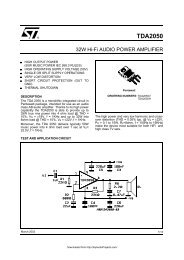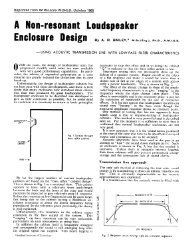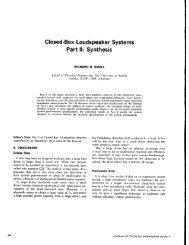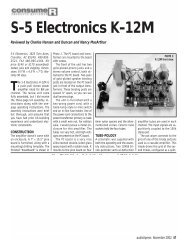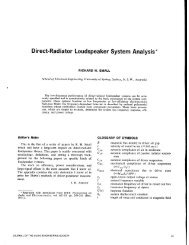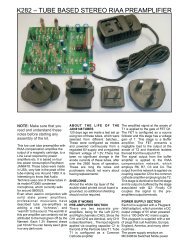A Model of Open-Baffle Loudspeakers - DIY Audio Projects
A Model of Open-Baffle Loudspeakers - DIY Audio Projects
A Model of Open-Baffle Loudspeakers - DIY Audio Projects
Create successful ePaper yourself
Turn your PDF publications into a flip-book with our unique Google optimized e-Paper software.
A <strong>Model</strong> <strong>of</strong> <strong>Open</strong>-<strong>Baffle</strong> <strong>Loudspeakers</strong><br />
5025 (H-6)<br />
Juha Backman<br />
Nokia Mobile Phones<br />
FIN-00045 Nokia Group, Finland<br />
Presented at<br />
the 107th Convention<br />
1999 September 24-27<br />
New York<br />
This preprint has been reproduced from the author’s advance<br />
manuscript, without editing, corrections or consideration by the<br />
Review Board. The AES takes no responsibility for the<br />
contents.<br />
Additional preprints may be obtained by sending request and<br />
remittance to the <strong>Audio</strong> Engineering Society, 60 East 42nd St.,<br />
New York, New York 10165-2520, USA.<br />
All rights reserved. Reproduction <strong>of</strong> this preprint, or any portion<br />
there<strong>of</strong>, is not permitted without direct permission from the<br />
Journal <strong>of</strong> the <strong>Audio</strong> Engineering Society.<br />
AN AUDIO ENGINEERING<br />
SOCIETY PREPRINT
0 Abstract<br />
A <strong>Model</strong> <strong>of</strong> <strong>Open</strong>-<strong>Baffle</strong> <strong>Loudspeakers</strong><br />
Juha Backman<br />
Nokia Mobile Phones<br />
P.O. Box 100<br />
Nokia Group<br />
Finland<br />
E-mail: juha.backman@nokia.com<br />
The open-baffle loudspeaker is, although structurally very simple, a challenge for modelling. This<br />
paper presents a computationally efficient model for predicting the frequency response and the<br />
polar pattern <strong>of</strong> an open-baffle loudspeaker. The baffle is modelled using time-domain geometrical<br />
theory <strong>of</strong> diffraction, and the conventional driver model is complemented with simple additions to<br />
approximate the acoustical asymmetry <strong>of</strong> the structure.<br />
1 Introduction<br />
<strong>Open</strong>-baffle loudspeakers are the longest-known1 and structurally simplest loudspeakers, but they,<br />
at the same time, pose considerable theoretical challenges for the modelling. A simple dipole model<br />
partially explains some <strong>of</strong> their features, but such a model is valid only at very low frequencies, and<br />
the parameters <strong>of</strong> the model (e.g. the effective size <strong>of</strong> the dipole) are difficult to determine. The<br />
simple dipole model fails in several respects: it is impossible to take into account asymmetry and<br />
other baffle shape effects, the mid-frequency polar pattern is not predicted correctly, etc. Thus<br />
taking into account both driver properties and baffle geometry is needed.<br />
The open-baffle speakers do, in addition to being theoretically interesting, have some practical<br />
importance. Dipole loudspeakers (and other gradient loudspeakers) provide a constant directivity<br />
also at low frequencies. They also excite fewer low-frequency room modes (although the benefit <strong>of</strong><br />
this is not self-evident) and their acoustical power output is affected by side boundaries much less<br />
than the output <strong>of</strong> omnidirectional speakers*.<br />
Despite these advantages the open-baffle speakers are far from being ideal wo<strong>of</strong>ers. Their wellknown<br />
practical problem is their inability to produce adequate low-frequency output. This is a<br />
problem particularly with electrostatic and ribbon units (which otherwise are not being discussed<br />
within this paper), where the displacement is limited, and there is a trade-<strong>of</strong>f between the<br />
displacement and the sensitivity. Larger volume velocities can be achieved by using dynamic<br />
wo<strong>of</strong>ers, but to maximise their output, a baffle is needed around the driver. The low frequency<br />
(dimensions (( a) output <strong>of</strong> a dipole is proportional to both the volume velocity and the linear<br />
dimensions, so doubling the baffle size equals doubling the displacement. This baffle in turn creates<br />
’ HUNT, FREDERIK V.: Electroacoustics. The Analysis <strong>of</strong> Transduction, and Its Historical Background. Harvard<br />
University Press, 1954; reprint Acoustical Society <strong>of</strong> America, 1982, pp. 86 - 87.<br />
* MORSE, PHILIP M.; INGAARD, K. UNO: Theoretical Acoustics, McGraw-Hill, Inc., New York, 1968; reprint Princeton<br />
University Press, Princeton, 1986, pp. 372 - 375.<br />
1
easily problems with mid-frequency response and polar pattern, thus losing the advantages <strong>of</strong> the<br />
open baffle and constraining the usable frequency range.<br />
2 Computational model<br />
2.1 Overview<br />
The open-baffle loudspeaker discussed in this paper consists <strong>of</strong> a rigid, flat baffle and a circular<br />
driver (or multiple drivers) placed at an arbitrary location on the baffle. If only first-order scattering<br />
is being studied, the only formal constraint on the baffle shape is that the edge is at least almost<br />
convex (i.e. a straight line drawn outwards from the source encounters the edge only at one point;<br />
some global concavity is allowed, so far as this condition is fulfilled). When multiple scattering is<br />
computed, then the baffle edge has to be convex. Of course in practice only few simple geometries<br />
are encountered. The acoustical behaviour <strong>of</strong> the baffle is described by using time-domain<br />
geometrical theory <strong>of</strong> diffraction, considering both sides separately; important observation that<br />
simplifies the analysis is that if the driver is assumed to be symmetrical, then the signal impinging<br />
on the edge is identical, but <strong>of</strong> opposite phase. If simple geometries are considered, then analytical<br />
expressions or simple closed-form approximations can be obtained for the impulse responses.<br />
The driver can be regarded to operate almost independently <strong>of</strong> the acoustical load provided by the<br />
baffle, and thus a frequency-domain lumped-component description is appropriate. A significant<br />
aspect <strong>of</strong> the driver function, regarding especially open-baffle applications, is the acoustical<br />
asymmetry provided by the chassis, etc. A simple approximation for the asymmetry, which<br />
improves the accuracy <strong>of</strong> predicting mid-frequency polar pattern and response, is to model the<br />
chassis as a Hehnholtz resonator, which then acts as an acoustical low-pass filter for the rear side <strong>of</strong><br />
the driver.<br />
For the purposes <strong>of</strong> creating an efficient model for the open-baffle speaker, several simplifying<br />
assumptions need to be made:<br />
- baffle is thin enough as compared to the wavelength in order to be regarded as infinitely<br />
thin. In practice this limits the validity <strong>of</strong> the model to baffles thinner than about W4.<br />
- the radiation from the driver can be approximated by a rigid, circular piston. The frequency<br />
responses <strong>of</strong> the front and rear sides, however, need not be identical (section 2.9, although<br />
a symmetrical driver enables further simplification <strong>of</strong> the model.<br />
- baffle vibration is ignored. This does not affect the accuracy <strong>of</strong> the diffraction model, but<br />
as the baffle area may be much larger than the driver area, the baffle vibration can have a<br />
great practical significance.<br />
According to these assumptions, the radiation consists <strong>of</strong> three components (Figure 1):<br />
- direct sound from the driver<br />
- sound radiated from the front <strong>of</strong> the driver and scattered from the edges<br />
- sound radiated from the rear <strong>of</strong> the driver and scattered from the edges<br />
The direct sound can be calculated effectively; the challenges are in determining the near-field<br />
sound caused by the driver at the edge and the field scattered from this sound.
Edge<br />
scattering<br />
from f?ont<br />
Direct sound<br />
Edge<br />
scattering<br />
from re&<br />
Driver<br />
J<br />
L<br />
<strong>Baffle</strong><br />
Figure 1. The components <strong>of</strong> sound radiated by a speaker in a finite open baffle. As indicated<br />
below, the scattering strength is determined by the angle 8 measured from the front surface <strong>of</strong> the<br />
baffle.<br />
We start by analysing the diffraction<br />
between the edge point<br />
<strong>of</strong> sound emitted by a point source in a baffle. The distance<br />
Figure 2. Parameters for describing a point source on a rectangular baffle.<br />
Angle CJ.I can be as a function <strong>of</strong> time in the form<br />
Equation 1<br />
cp = arccosi<br />
The diffracted sound can be represented by directional secondary sources distributed along the edge<br />
<strong>of</strong> the baffle. The strength <strong>of</strong> the source can be determined by applying the principle <strong>of</strong> reciprocity<br />
and the angular dependence <strong>of</strong> the sound scattered from an edge point to an angle 8 in a plane<br />
normal to the edge can be expressed by an equation presented by Vanderkooy3, which for a thin<br />
knife-edge wedge simplifies to<br />
Equation 2 W) = cosnJy~~s(j,2 = -co;(.j,2<br />
3 VANDERKOOY, JOHN: A Simple Theory <strong>of</strong> Cabinet Edge Diffraction. JAES, vol. 39, December 1991, pp. 923 - 933;<br />
reprinted in the AES Anthology <strong>Loudspeakers</strong>, vol. 3, pp. 230 - 242.<br />
3
The shortcoming <strong>of</strong> this form is that its behaviour near the shadow edge is problematic, but both the<br />
illuminated and the shadow regions themselves, especially near the loudspeaker axis, behave rather<br />
well.<br />
The sound pressure created at distance r by the radiation Corn an edge surrounding an open baffle<br />
loudspeaker consists <strong>of</strong> the contributions <strong>of</strong> the positive and the negative side,<br />
Equation 3 p = pd;;;dtF(e) + pd;;;dtF(2w9)= pd;;;dt-co$,2 +pd~;;dtcos;,2<br />
If the driver can be regarded as symmetrical, as usually at low frequencies, then the scattered sound<br />
pressure can be simplified to the form<br />
Equation 4 p = - pdqfdt 2<br />
4nr case/2<br />
When the observation point is not in the normal plane <strong>of</strong> the edge, then the sound pressure is to be<br />
multiplied by a factor 1 /co& where c is the angle between the propagation direction and the normal<br />
plane.<br />
2.2 Near-field radiation<br />
Although the general near-field radiation problem is notoriously difficultd, especially when the<br />
calculations are performed in the frequency domain, the problem can be simplified greatly for the<br />
purposes <strong>of</strong> the computation <strong>of</strong> diffraction. When the field point is constrained to the same plane as<br />
the surface <strong>of</strong> the piston, approximate frequency-domain calculation <strong>of</strong> the radiation can be done<br />
relatively efficiently. In the time domain the situation is even more interesting, since the radiation<br />
can be represented by a simple exact expression.<br />
I ,-- Driver<br />
Field point<br />
(baffle edge)<br />
Figure 3. Geometry used in determining the near-field radiation.<br />
The sound pressure dp generated by an area element dA on a piston vibrating with velocity u is<br />
4 STENZEL, H.: tier die Berechung des Schallfeldes von kreisfirmigen Membranen in starrer Wand, Annalen der<br />
Physik, vol. 6, n:o 4, 1949, pp. 303 - 324.<br />
4
Equation 5<br />
dp =--=PdudA, P dq<br />
4x?? dt<br />
4nR dt<br />
where R is the distance between the field point and the element dA. The distance can be also written<br />
as R = ct, where t is the propagation time and c the speed <strong>of</strong> sound.<br />
The surface points corresponding to the sound received at time t form an arc with a radius ct (Figure<br />
3). The area <strong>of</strong> the surface element is dA = ctd@dt, which implies that the total sound radiated at<br />
time t is<br />
Equation 6 p =<br />
‘I2 pdufdt<br />
I<br />
-912 4nzt<br />
ctd@ =<br />
pdu I dt<br />
4x<br />
e-<br />
The angle @ can be shown to be<br />
Equation 7<br />
$ = arccos<br />
d2 + (ct)2 - a2<br />
2ctd ’<br />
from which the sound pressure can be written as<br />
Equation 8<br />
duldt<br />
p = -<br />
4x<br />
d2 + (ct)2 - a2<br />
arccos ,(d-a)lc
1<br />
0.9<br />
0.8<br />
3 0.7<br />
Ti 5 0.6<br />
u 0.5<br />
8<br />
z 0.4<br />
8 E 0.3<br />
0.2<br />
0.1<br />
0<br />
-0.6 -0.4 -0.2 0 0.2 0.4 0.6<br />
Time<br />
Figure 4. Impulse response at different distance from the source (normalised to the maximum<br />
value): solid line: distance = 2 times driver radius, dashed line: distance = 3 times driver radius,<br />
dotted line: distance = 5 times driver radius, dash-dot line: distance = 100 times driver radius.<br />
If the model is used calculate the behaviour <strong>of</strong> a free piston (a totally unbaffled speaker), then the<br />
radiation model will be numerically difficult (a division by zero) just at the edge. (Analytically, the<br />
limiting value can be still shown to be correct.) The numerical difficulties can be circumvented e.g.<br />
by assuming a very narrow annular baffle around the driver.<br />
2.3 Multiple scattering<br />
For qualitative description <strong>of</strong> mid-frequency behaviour, the multiple scattering effects can be<br />
ignored. Vanderkooy has demonstrated in his papers, however, that taking multiple scattering is<br />
essential for describing low frequencies accurately. As shown later, the effect is even more<br />
pronounced for open-baffle speakers. To simplify the analysis the edge is represented again by a<br />
discrete set <strong>of</strong> points. The geometry <strong>of</strong> baffle has now to be limited to convex shapes, however,<br />
since a sound propagating between any arbitrary edge points has to stay inside (or on) the edge.<br />
When calculating multiple scattering the sound propagating on both sides <strong>of</strong> the baffle has to be<br />
taken into account.<br />
5 VANDEERKOY, ref. 3.
Figure 5. Schematic representation <strong>of</strong> multiple scattering. Thick solid line = first sound from driver<br />
to edge; solid thin line = second-order scattering; dashed line = third-order scattering.<br />
Although the multiple scattering process can be from signal processing point <strong>of</strong> view regarded to be<br />
an IIR filter, representing it as a conventional filter will result in a rather complex and thus memoryconsuming<br />
network. An alternative way is to represent the signal an edge point as a polynomial <strong>of</strong> z-<br />
’ and to use a matrix representation for the multiple scattering:<br />
Equation 10<br />
Pl<br />
P2<br />
a1,2 ’ a3,2 a 42<br />
P3 = al,3 a2,3 0 an,3<br />
.<br />
. .<br />
. . .<br />
P n-N+1 Ul,tl a2,n a34 *** 0<br />
Pl<br />
P2<br />
P3<br />
PVl<br />
where N is the order <strong>of</strong> scattering; N = 1 is the first sound arriving from the driver to the edge point.<br />
Each matrix element a,, consists <strong>of</strong> a real coefficient representing the scattering amplitude from<br />
point i toj and an exponential z-~(‘~)“, where D(ij) is the distance between the points. In practice the<br />
distance (divided by c) can be truncated to the closest integer value to keep the computation simple.<br />
If the baffle has straight edges, then the scattering coefficient between any points on the same edge<br />
is zero. The multiple scattering matrix is independent <strong>of</strong> the driver size or position.<br />
The multiplication <strong>of</strong> the vector consisting <strong>of</strong> the polynomials by the matrix resembles the<br />
convolution <strong>of</strong> the two; the delays represented matrix, however, are not uniformly spaced or<br />
consecutively ordered in each column. Each multiplication corresponds to an operation <strong>of</strong> delaying<br />
and attenuating the sample. The operation could be turned into a proper convolution by arranging<br />
each column <strong>of</strong> the matrix by the power <strong>of</strong> z-‘, merging elements corresponding to the same power<br />
and writing the result as an impulse response.<br />
Each scattering naturally lengthens the impulse response. The number <strong>of</strong> samples added can be<br />
estimated simply from the maximum dimension <strong>of</strong> the baffle. For a 1 * 1 m2 baffle the length <strong>of</strong> the<br />
diagonal is about 1.4 m, which at 100 kHz sampling rate equals about 412 samples. Thus, after 5<br />
scatterings the original impulse response is lengthened only about by 2000 samples.
2.4 Far-field radiation<br />
2.4.1 Radiation from the driver<br />
As far as the direct sound only is concerned, the driver can be regarded to reside in an infinite, flat<br />
plane. This approximation can be used even with completely free pistons, since the diffracted part is<br />
taken separately into account. There are two ways <strong>of</strong> representing the far-field direct radiation from<br />
a rigid piston: in frequency domain and in time domain. The frequency-domain expression for the<br />
sound pressure created by a piston vibrating with a volume velocity q and a frequencyfat distance r<br />
and angle 8 can be represented by the familiar expression6<br />
zypq 2 J1 (ka sin 0)<br />
Equation 11 p = --<br />
r kasine<br />
and the time-domain radiation corresponding to a step displacement A by the following<br />
equationy:<br />
Equation 12 p =<br />
r-ct<br />
a2 sin2 8 - (r - ct)2<br />
ct
problematic in the actual implementation <strong>of</strong> the algorithm, since the non-causal part <strong>of</strong> the energy is<br />
small, and since there will be some initial delay from the propagation from the source to the edge<br />
point, even windowing away the part causing non-causality in the final result will not have a strong<br />
effect on the energy.<br />
After the delays and amplitudes corresponding to each edge point have been determined, then the<br />
impulse responses on each edge point are delayed and attenuated by the appropriate amount and<br />
added. If fractional delays are used, then this involves explicitly convolving the delay and the<br />
impulse response. The use <strong>of</strong> fractional delays will increase the computation per edge point, but the<br />
number <strong>of</strong> points will be reduced, which reduces the computational load at earlier stages and<br />
reduces the amount <strong>of</strong> memory needed.<br />
The polar pattern can be obtained by computing the frequency response to several angles and<br />
tracking the behaviour <strong>of</strong> a single frequency. An alternative way, which is faster if only a few<br />
frequencies are computed, is to go back to the definition <strong>of</strong> the Fourier transform and compute the<br />
inner product <strong>of</strong> the impulse response to the desired angles with sinusoidals corresponding to the<br />
desired frequencies. This yields the spectrum component at that particular frequency. As the<br />
magnitude <strong>of</strong> the transfer function is needed, then for each frequency the multiplication should be<br />
done with both a sine and a cosine signal, yielding the imaginary and the real parts.<br />
2.5 Practical drivers<br />
When the frequency range <strong>of</strong> interest goes well above the fundamental resonance <strong>of</strong> the driver, the<br />
structural asymmetry <strong>of</strong> a typical transducer must be taken into account. In typical loudspeakers a<br />
simple approximation for the structure is to model the volume between the diaphragm and the<br />
chassis and the chassis holes as a Hehnholtz resonator. The practical problem <strong>of</strong> this kind <strong>of</strong> model<br />
is that the effective port length becomes difficult to determine computationally, since the distance<br />
between the holes and the diaphragm is roughly similar to the dimensions <strong>of</strong> the holes, and the<br />
baffle hole etc. will influence the effective length. The Hehnholtz resonator model, however, gives<br />
a reasonable qualitative approximation for the asymmetry in the frequency response, although the<br />
asymmetry <strong>of</strong> the radiation pattern (both near-field and far-field) is still ignored.<br />
Port formed by chassis<br />
holes and baffle<br />
Volume<br />
between<br />
diaphragm and<br />
chassis<br />
Figure 6. Geometrical parameters describing the Helmholtz resonator approximation for the rear <strong>of</strong><br />
the driver.
Bli<br />
Figure 7. Simple equivalent circuit <strong>of</strong> a driver, using a Helmholtz resonator to describe the<br />
structural asymmetry.<br />
One interesting feature <strong>of</strong> the simple model described here is that it qualitatively explains why an<br />
unbaffled or open-baffle loudspeaker becomes almost omnidirectional at some frequency band in<br />
the midrange. Near and above the Helmholtz resonance frequency the driver and chassis port<br />
velocities are almost in phase (Figure 8), so the cancellation between front and rear radiation is<br />
reduced (and at right angle the sound from both sides is in phase), which typically creates a wider<br />
radiation pattern than the driver would have had at the same frequency in an infinite baffle or a<br />
sealed enclosure. The optimum condition for omnidirectional radiation (about equal magnitudes,<br />
small phase difference) occurs slightly above the Helmholtz resonance frequency.<br />
10
a)<br />
/ Frequency/Hz<br />
0<br />
%<br />
a, b -50<br />
P<br />
8<br />
5<br />
g-100<br />
.-<br />
-0<br />
%<br />
E-150<br />
b)<br />
-200<br />
10’ lo2 -IO3 lo4<br />
Frequency/Hz<br />
Figure 8. Magnitude (a) <strong>of</strong> the sound pressure radiated by the front (solid) and rear (dashed) sides a<br />
speaker described by the equivalent circuit in Figure 7 and the phase difference between the front<br />
and the rear radiation (b). In this example the fundamental resonance is at 100 Hz and the chassis<br />
Hehnholtz resonance at 2 kHz.<br />
Using this kind <strong>of</strong> model the acoustical asymmetry can be regarded as a factor independent <strong>of</strong> the<br />
diffraction and the radiation. Thus impulse responses using an idealised source (with a flat response<br />
in the far-field on-axis in an infinite baffle) can be used to model the diffraction and the direct<br />
sound in the time domain, and the responses can then be transformed into frequency domain to be<br />
multiplied by the driver responses and finally to be added (Figure 9).<br />
11
Front diffraction Total front FFT Driver front<br />
for ideal piston --) radiation (TD) + + frequency<br />
VW response (FD)<br />
h<br />
Rear diffraction<br />
for ideal piston<br />
0-D)<br />
Total rear<br />
radiation (TD)<br />
Added to front or rear<br />
i observation direction<br />
FFT<br />
Driver rear<br />
frequency<br />
response (FD)<br />
Total radiation<br />
0-j<br />
A<br />
Figure 9. Steps in calculating the total response taking into account the driver properties. TD = time<br />
domain calculation, FD = frequency domain calculation.<br />
In practical design work a it is possible to mount the driver in a large baffle (significantly larger<br />
than the target size <strong>of</strong> the final design) or a wall, with a large space behind it, and to measure the<br />
near-field impulse response in the plane <strong>of</strong> the baffle at some distance(s) appropriate for the<br />
intended final design. The measurements have to be performed for the both sides <strong>of</strong> the driver using<br />
a baffle as thick as the one to be used in the final design, since the baffle thickness affects strongly<br />
the asymmetry <strong>of</strong> the radiation.<br />
The radiation load (for the purposes <strong>of</strong> this model, mainly attached mass) changes slightly when the<br />
driver is in a finite baffle, and thus the resonance is frequency between the free-air and the infinitebaffle<br />
values. This can be taken into account by starting with the idealised piston model and<br />
calculating the average diffracted sound pressure across the driver on the other side; this yields then<br />
a term comparable to the mutual radiation impedance between the driver sides. The correction is<br />
small, however.<br />
3 Low-frequency approximation<br />
At very low frequencies the open baffle starts to behave as an ideal dipole, exhibiting the figure-<strong>of</strong>eight<br />
polar pattern and the additional 6 dB/oct. attenuation as compared to the same driver in an<br />
infinite baffle. This low-frequency limit determines the choice <strong>of</strong> driver parameters (resonance<br />
frequency, Q) needed. The radiation <strong>of</strong> an ideal dipole can be determined from two parameters:<br />
volume velocity <strong>of</strong> the individual monopoles comprising the dipole and their distance. The effective<br />
distance is determined from the baffle size and the placement <strong>of</strong> the driver. As the numerical<br />
example in the next section indicates, however, the first-order scattering model yields too low an<br />
amplitude at the low frequencies and too high a frequency for the first minimum, which would<br />
suggest that the effective distance should be determined from a series expansion describing the<br />
multiple scattering.<br />
The effective distance can be assumed to be average distance from the centre <strong>of</strong> the driver to the<br />
edge, calculating the average over the angle measured from the driver (Figure 10). This type <strong>of</strong><br />
averaging is justified by noting that the sound energy is radiated from the driver to all directions in<br />
about the same manner, so the angle averaging equals energy averaging.<br />
12
Figure 10. The parameters describing the average distance from the edge.<br />
For a rectangular baffle the distance can be written as<br />
Equation 13 r(0) = & ,<br />
where r, is the distance from the edge under study and 8 the angle calculated for that particular<br />
edge. If the edge is delimited by angles 8,,, and 0,,, then the average distance is<br />
Equation 14<br />
Taking the uppermost edge as an example, the minimum and maximum angles for an edge can be<br />
defined from the geometry <strong>of</strong> the baffle as<br />
Equation 15<br />
X0<br />
%in = -arcsin<br />
x0” +Y;<br />
0 = arcsin Xl ’<br />
max<br />
x: +Y:<br />
from which the average distance for this particular edge can be written as<br />
Equation 16 rave, r =<br />
1<br />
11<br />
Xl X0<br />
arcsin + arcsin<br />
xf +yo2 4 +Yo2<br />
Repeating this for other edges yields the total average distance, from which can be computed the<br />
estimate for the on-axis sound pressure at distance r<br />
. 2<br />
Equation 17 p = zp~~~<br />
13
where 4 is the volume velocity corresponding to one side <strong>of</strong> the driver.<br />
The frequency <strong>of</strong> the first minimum (on-axis) is according to this model<br />
Equation 18 fti<br />
= c<br />
r ave<br />
4 Numerical example<br />
The results obtained by the method are illustrated by the results obtained from the baffle illustrated<br />
below (Figure 11).<br />
300<br />
< ><br />
Figure 11. The<br />
200<br />
T<br />
0100<br />
-: ” L<br />
100<br />
-l<br />
400<br />
baffle used in the examples (all dimensions in mm).<br />
0.4 ,<br />
0.35 -<br />
43<br />
.z 0.3 -<br />
-6<br />
kii 0.25 -<br />
8<br />
6 0.2-<br />
5:<br />
!!? 0.15-<br />
1<br />
2 0.1 -<br />
z<br />
0.05 -<br />
o-<br />
0 0.001 0.002 0.003 0.004 0.0050.006 0.007 0.008 0.009 0.01<br />
Time/s<br />
Figure 12. Impulse response <strong>of</strong> the first-order scattered sound.<br />
14
0.025,<br />
I<br />
$ 0.02 -<br />
3<br />
.z<br />
E 0.015-<br />
crs<br />
8<br />
g 0.01 -<br />
z:<br />
f!J<br />
a, 0.005 -<br />
u,<br />
2<br />
E o- \ ”<br />
-0.005 I<br />
0 0.001 0002 0 003 0.004 0.005 0.006 0.007 0.008 0.009 0.01<br />
Time/s<br />
Figure<br />
order,<br />
13. Impulse response <strong>of</strong> the scattered sound, taking into account the scattering up to Sh<br />
An interesting feature is that the average decay characteristics are almost perfectly exponential<br />
(Figure 14).<br />
-20<br />
-40<br />
-60 t<br />
%<br />
3i -80 -<br />
2 -100 -<br />
"a<br />
fii -120 -<br />
E-,40<br />
3<br />
-<br />
2 -160 -<br />
6<br />
-180 -<br />
0 0.001 0.002 0.003 0.004 0.005 0.006 0.007 0.008 0.009 0.01<br />
Time/s<br />
Figure 14. Decay characteristics <strong>of</strong> the scattered sound, plotted on a logarithmic scale.<br />
The importance <strong>of</strong> multiple scattering is clearly illustrated from the frequency responses calculated<br />
using the impulse responses shown above. (The edge impulse response is subtracted from the direct<br />
sound, if the sign <strong>of</strong> the diffracted sound is chosen as illustrated; in a physical system the sign <strong>of</strong> the<br />
diffracted sound in the illuminated region is opposite to the direct sound, and in the shadow region<br />
the same.) The response predicted using only single diffraction indicates too much low-frequency<br />
attenuation and too large local minima and maxima in the response.<br />
15
5<br />
0<br />
%<br />
B<br />
3<br />
g<br />
E<br />
a -5<br />
/<br />
.<br />
. . .<br />
. \<br />
. . .<br />
. . .<br />
. . . .<br />
-10<br />
lo2<br />
IO3<br />
Frequency/Hz<br />
lo4<br />
Figure 15. Frequency response corresponding to 1 St-order scattering (dashed line) and Sh-order<br />
scattering (solid line).<br />
5 Conclusions<br />
The method presented here enables a fast calculation <strong>of</strong> the characteristics <strong>of</strong> an unbaffled<br />
loudspeaker. The model is quite usable for calculating the frequency response up to angles<br />
approaching the shadow boundary, but is problematic in predicting the behaviour at the plane <strong>of</strong> the<br />
baffle. The numerical simulations shown indicate clearly that multiple scattering has to be taken<br />
into account.<br />
16


